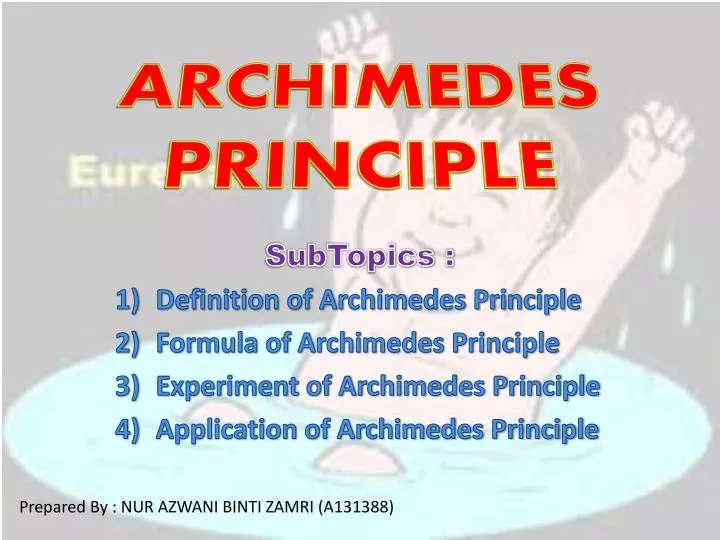

Know more details like experiments, examples, FAQs etc. Some possible errors in this lab could have been simple human error in reading the mass balances wrong, also the mass balances themselves could have been reading wrong, and finally the string that was attached to the object when measuring the objects apparent mass can influence our measurement a very minute amount but was a measurable one. The Archimedes principle is concerned with the forces exerted on an object by the fluids that surround it. This helps show to us that Archimedes principle can be used as an accurate way to calculate out an objects density. Since the two values where so close together we got very low percent differences. These calculated values very closely match those that where calculated using the second method of simply dividing the objects mass by its volume. By using the statement of the buoyant force acting on an object is equal to the weight of the liquid displaced by that object we where able to fairly accurately determine the density of the fluid the object is suspended in. In this lab we used data that we collected to investigate Archimedes principle.

Archimedes first measured the mass of the crown (m 0 0.44 kg) and then its apparent mass, when the crown was immersed in water (m’ 0.409 kg). He suspected it was made of a cheaper metal. Slowly slide the object being used in the cylinder. According to the legend, Hiero II of Syracuse asked Archimedes to determine without damaging it if a crown he has ordered was really made of gold.Now take a graduated cylinder and fill it up with any liquid to the 40mL mark.Record the apparent mass of the object in all of the liquids that are being used.Make sure the object is not touching any sides of the beaker to effect the mass balances reading.Submerge the object in the liquid in the beaker.Tie a string through the object and hang this string on the end of the hook apparatus.Next set up mass balance to record apparent weight, to do this use the hook apparatus.Repeat this for all other liquids that are desired to be used.Record the mass and the volume of the liquid before submerging the object.Fill a beaker with one of the random liquids and place it on the mass balance after zeroing the mass balance with the empty beaker.Take the normal mass of the object that will be used.First derive an equation that can be solved for the density of the fluid by using values that can be measured when the object is suspended in the fluid.Investigation of whole bones is more biologically relevant, and both techniques were effective in detecting differences between whole femurs from low-vitamin D and supplemental-vitamin D colony rats. Colony effects for hollowed femur densities were diminished with Archimedes' principle (p < 0.03) and eliminated with DXA (p < 0.53). Hollowed femur density values were higher than whole femur values with Archimedes' principle but lower with DXA. Other variables such as femur ash weight and calcium content were also highly correlated to densities with both techniques. Actual density values were higher for Archimedes' principle than for DXA. Have the volunteer write 'rock in boat' on a sticky note and place the sticky note on the outside of the clear.

Choose a volunteer and ask him to come to the front of the class and place the rock in the boat. Tell students that the activity today will show them how Archimedes principle works. Whole femur densities were higher for supplemental-vitamin D colony rats than for low vitamin D rats using both techniques (Archimedes' principle, p < 0.002 DXA, p < 0.005), and the densities from the two techniques were highly correlated (r = 0.82, p < 0.0001). Place the model boat in the water so it floats. In an attempt to ensure detectable treatment differences, rats were used from a low-vitamin D Holtzman and a supplemental-vitamin D Sprague-Dawley colony. We compared Archimedes' principle and DXA (Hologic QDR-2000) in the measurement of the densities of whole and hollowed femurs of 5- to 6-month-old retired female breeder rats.
#Archimedes principle example software#
A recent development has been software for the determination of "density" (g/cm2) of small animal bones with dual-energy X-ray absorptiometry (DXA). Example Problem 1 - Applying Archimedes' Principle to Find the Mass of an Object A solid wood raft with a rectangular base measuring 3 meters by 5 meters floats in a still pond. The standard method for determination of density (g/cm3) of bones from small animals has been the application of Archimedes' principle.


 0 kommentar(er)
0 kommentar(er)
